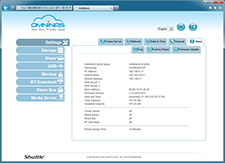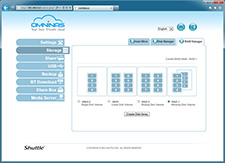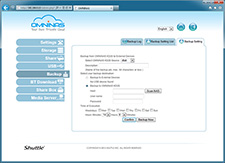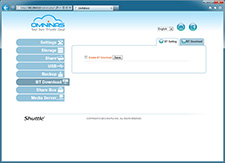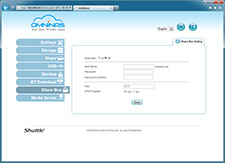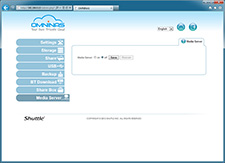Getting Up and Running
Two-bay NAS units are ideal for home users who value their data, and setting up the KD20 in a RAID 1 configuration - where all your data is 'mirrored' to a second drive, so you always have a backup - is as easy as slotting in two hard drives, powering on and following the on-screen wizard.
Each drive bay is easily removed via a pull-to-release mechanism, but Shuttle has kept to the very basics. Neither drive bay offers mounts for 2.5in disks, and, save for the rubber feet underneath the chassis, there's little attempt to dampen vibration. During use, the entire unit vibrates when the hard drives are running flat-out, making it quite noisy and bothersome; to the extent that we could feel the vibration on our hand as it passed through the desk and into our mouse a couple of feet away.
Shuttle could really do with a couple of rubber mounts on the drive trays to reduce vibration-related noise, but on the plus side, the KD20's 80mm internal fan makes hardly any noise at all. By default, the fan is set to remain off if hard-disk temperature remains below 54ºC, though it kicks into low speed at 55ºC and high speed at 60ºC. Shuttle's got the right idea, but we found our Samsung hard disks getting too warm to the touch before the fan would kick in, and for those who prefer to prioritise drive safety ahead of low-noise operation, there's no option to manually enable the fan.
Quite a few NAS solutions bamboozle casual users with an elaborate feature set, but Shuttle continues the keep-it-simple theme in its Linux-based operating system. You can access it by entering the NAS IP in your browser (or by using the Finder utility bundled on CD) and, even if you're new to network-attached storage, you'll find it generally easy to use.
The admin panel is divided into eight core sections - Settings, Storage, Share, USB, Backup, BT Download, Share Box and Media Server - and the self-explanatory names sum up all of the KD20's features. As with most home-user solutions, Shuttle includes an iTunes server, a DLNA media server and a BitTorrent download client, as well as cloud sharing and network printer support.
There's no FTP client - a surprise omission - but while Shuttle has most of the basics covered, they're exactly that; basic. It's easy to add multiple users and create new folder-shares, but you can't create groups, so permissions have to be managed on a per-user basis. Similarly, backups have to be managed folder-by-folder (you can't simply backup the entire NAS) and there's no option to backup to the cloud; it has to be an external drive or another NAS on the network.
The built-in personal cloud - dubbed Share Box - makes it easy to gain remote access by configuring a sub-domain of omninas.net, and there are simple apps available for Android and iOS, giving most users the ability to view content from their smartphone/tablet device.
One of the biggest limitations we've found, however, is with the BitTorrent client and DLNA media server; the two can't be activated at the same time - you have to disable one to use the other. We're not sure if this is a hardware limitation, but it's something Shuttle needs to revisit in a future update. And, while we're at it, the media server could be made more configurable. As it stands, all media has to be dumped into the default iTunes folder, there's no option to have the server scan different folders, and even content in sub-folders doesn't appear in the database.
Overall, Shuttle's on the right track. For a first-generation attempt, it has built a user interface from the ground-up that's simple to navigate and easy to use. The foundation is here, but Shuttle now needs to take the extra steps and roll out firmware updates that add extra functionality and a greater range of configuration options.







